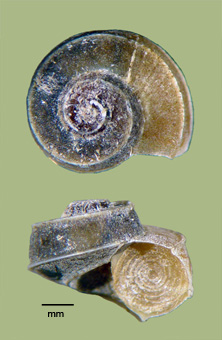> Habitat & Distribution
Populations of V. tricarinata range across the northern United States and Canada from New York through Iowa to the Rockies, typically in aquatic vegetation in rich, perennial lakes, ponds and rivers above the glacial maximum (Clarke 1981, Jokinen 1992, Stewart 2006). They are not uncommon in northern New Jersey and Pennsylvania, through the upper Midwest into The Dakotas.
Valvata tricarinata populations become much more uncommon further south, however. We have five records in our database from drainages of The Ohio, none from The Tennessee/Cumberland. Populations are uncommon in Nebraska (Stephen 2015), entirely absent from Kansas (Leonard 1959). We are aware of several records of Valvata populations from the vicinity of Washington DC, historical reports from Virginia interior drainages (Beetle 1973, Stewart & Dillon 2004), and a single isolated record from the Savannah River on the South Carolina / Georgia border.
Within lakes the distribution of V. tricarinata seems to be contagious (Dillon 2000:404), populations often reaching maximum densities in deeper waters (Pace et al. 1979). FWGNA incidence rank I-3p, peripheral in our 17-state study area.
> Ecology & Life History
Populations of V. tricarinata typically display annual, semelparous life cycles (A), gelatinous masses of 10 - 30 eggs being laid on solid substrates during the spring and summer (McKillop 1985, Jokinen 1992). Jokinen's (1987) analysis of the distribution of V. tricarinata in Connecticut and New York led her to classify it as a High-S species, found only in the most species-rich communities. Dillon s (2000: 360-363) reanalysis of these data suggested that V. tricarinata populations in Connecticut seem to be Undifferentiated with respect to life history adaptation.
The ciliated body and mantle extension demonstrated by V. piscinalis led Tsikhon-Likanina (1961) to suggest that valvatids may be filter-feeders, although this is by no means certain (Fretter & Graham 1962).
Valvata tricarinata was mentioned among the prey of pumpkinseed sunfish in Osenberg's (1989) study of Lawrence Lake, Michigan.
> Taxonomy & Systematics
The nomen Valvata tricarinata has been taxonomically stable since the early 20th century (Walker 1902). Valvata populations are notoriously polymorphic with respect to shell morphology, however, and the distinction between V. tricarinata and V. bicarinata (bearing two spiral carinae or angulations on the shell) seems tenuous at best.
> Maps and Supplementary Resources
- Valvata distribution in Atlantic drainages (2023)
- Valvata distribution in Georgia and the Florida panhandle (2025)
- Valvata in The Great Plains
> References
Beetle, D. (1973) A checklist of the land and freshwater mollusks of Virginia. Sterkiana, 49, 21-35.
Clarke, A.H. (1981) The Freshwater Molluscs of Canada. National Museum of Natural Sciences, National Museums of Canada, Ottawa, Canada.
Dillon, R. T., Jr. (2000) The Ecology of Freshwater Molluscs. Cambridge University Press, Cambridge.
Fretter, V. & Graham, A. (1962) British Prosobranch Molluscs. Ray Society, London.
Harman, W.N. (2000) Diminishing species richness of mollusks in Oneida Lake, New York State, USA. Nautilus 114:120-126.
Heard, W. H. (1963) Reproductive features of Valvata. The Nautilus 77: 64-68.
Jokinen, E. (1983) The freshwater snails of Connecticut. State Geol. Nat. Hist. Survey Bull. 109, Hartford, Connecticut. 83 p.
Jokinen, E. (1987) Structure of freshwater snail communities: species-area relationships and incidence categories. Am. Malacol. Bull., 5:9-19.
Jokinen, E. (1992) The freshwater snails (Mollusca: Gastropoda) of New York State. New York State Museum Bulletin, 482:1-112.
Leonard, A.B. (1959) Handbook of Gastropods in Kansas. Miscellaneous Publication Number 20, University of Kansas Museum of Natural History, Lawrence.
McKillop, W. (1985) Distribution of aquatic gastropods across the Ordovician dolomite - Precambrian granite contact in southeastern Manitoba, Canada. Can. J. Zool., 63:278-288.
Osenberg, C. (1989) Resource limitation, competition and the influence of life history in a freshwater snail community. Oecologia, 79:512-519.
Pace, G., Szuch, E. & Dapson, R. (1979) Depth distribution of three gastropods in New Mission Bay, Lake Michigan. Nautilus, 93:31-36.
Stephen, B.J. (2015) Species composition of Nebraska's freshwater gastropod fauna: A review of historical records. American Malacological Bulletin 33: 61-71.
Stewart, T.W. (2006) The freshwater gastropods of Iowa (1821-1998): species composition, geographic distributions, and conservation concerns. Amer. Malac. Bull. 21: 59 75.
Stewart, T. & Dillon, R. (2004) Species composition and geographic distribution of Virginia's freshwater gastropod fauna: A review using historical records. American Malacological Bulletin, 19, 79-91.
Tsikhon-Likanina, E. A. (1961) On the filtration method of feeding in Bithynia tentaculata (L) and Valvata piscinalis (Muller). Byvelleten Instituta Biologii Vodokhranilishch 10: 59 - 75.
Walker, B. (1902) A revision of the carinate valvatas of the United States. Nautilus, 15:121-125.
Walker, B. (1906) Notes on Valvata. Nautilus 20:25-32.








